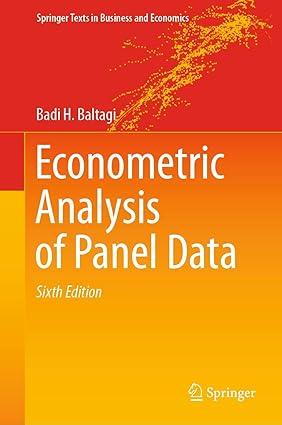Testing for correlated effects in panels. This is based on problem 95.2.5 in Econometric Theory by Baltagi
Question:
Testing for correlated effects in panels. This is based on problem 95.2.5 in Econometric Theory by Baltagi (1995a). This problem asks the reader to show that Hausman's test, studied in Sect. 4.3, can be derived from Arellano (1993) extended regression by using an alternative transformation of the data. In particular, consider the transformation given by \(H=\left(C^{\prime}, \iota_{T} / Tight)^{\prime}\) where \(C\) is the first \((T-1)\) rows of the Within transformation \(E_{T}=I_{T}-\bar{J}_{T}, I_{T}\) is an identity matrix of dimension \(T\), and \(\bar{J}_{T}=\iota_{T} \iota_{T}^{\prime} / T\) with \(\iota_{T}\) a vector of 1 's of dimension \(T\).
(a) Show that the matrix \(C\) satisfies the following properties: \(C \iota_{T}=0, C^{\prime}\) \(\left(C C^{\prime}ight)^{-1} C=I_{T}-\bar{J}_{T}\); see Arellano and Bover (1995).
(b) For the transformed model \(y_{i}^{+}=H y_{i}=\left(y_{i}^{* \prime}, \bar{y}_{i}ight)^{\prime}\), where \(y_{i}^{*}=C y_{i}\) and \(\bar{y}_{i}=\Sigma_{t=1}^{T} y_{i t} / T\), the typical element of \(y_{i}^{*}\) is given by \(y_{i t}^{*}=\left[y_{i t}-\bar{y}_{i}ight]\) for \(t=1,2, \ldots, T-1\). Consider the extended regression similar to (4.49)
\[\left[\begin{array}{c}y_{i}^{*} \\\bar{y}_{i}\end{array}ight]=\left[\begin{array}{cc}X_{i}^{* \prime} & 0 \\\bar{X}_{i}^{\prime} & \bar{X}_{i}^{\prime}\end{array}ight]\left[\begin{array}{l}\beta \\\gamma\end{array}ight]+\left[\begin{array}{c}u_{i}^{*} \\\bar{u}_{i}\end{array}ight]\]
and show that GLS on this extended regression yields \(\widehat{\beta}=\widehat{\beta}_{\text {Within }}\) and \(\widehat{\gamma}=\) \(\widehat{\beta}_{\text {Between }}-\widehat{\beta}_{\text {Within }}\), where \(\widehat{\beta}_{\text {Within }}\) and \(\widehat{\beta}_{\text {Between }}\) are the familiar panel data estimators. Conclude that Hausman's test for \(H_{0}: E\left(\mu_{i} / X_{i}ight)=0\) can be based on a test for \(\gamma=0\), as shown by Arellano (1993). See solution 95.2.5 in Econometric Theory by Xiong (1996).
Step by Step Answer:






